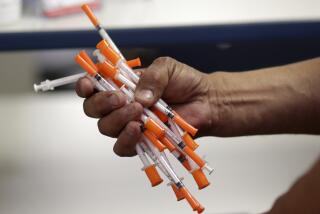Move to Screen Free HIV Tests Meets Opposition : Disease: State says the proposal to give preference to people who have engaged in high-risk behavior is merely a draft. Director of South Bay Free Clinic says it amounts to discrimination.
- Share via
Controversy has erupted over a state proposal to screen people seeking free, anonymous testing for the virus that causes AIDS, a move opposed by the South Bay’s major provider of such testing.
The proposed screening--generally conducted by telephone when a person tries to schedule a test--would give preference to clients who have engaged in so-called high-risk behavior, such as injecting drugs or gay male sex.
The proposal, which state officials say is merely a draft, attempts to assure that those people at high risk for HIV, or human immunodeficiency virus, would receive the services that they need, Wayne Sauseda , chief of the state Office of AIDS, said Wednesday.
A number of people receiving free, anonymous testing at state-funded sites “have low or very low risk factors for HIV infection,” he said.
Although state officials say the proposal, drafted in September, is subject to change, it nevertheless has drawn forceful criticism from some AIDS workers who say it would fly in the face of years of educating the public that gay men, prostitutes and drug users are not the only people at risk for AIDS, or acquired immune deficiency syndrome.
Critics maintain that the screening could discourage women, teen-agers and others who do not fit the traditional stereotypes of AIDS victims from testing for the disease.
“All it is is discrimination against people who believe they are at risk but do not fit in with what the state decides is high risk,” said Stewart Sokol, director of HIV and AIDS services at the South Bay Free Clinic, which has offices in three cities and is the area’s major source of free, anonymous testing.
The proposal “sends a clear message to a variety of communities that only the white, gay, male population is affected by this disease,” added Darrel Cummings, health services director at the Los Angeles Gay and Lesbian Community Services Center. He and other critics were also skeptical that people already apprehensive about calling for a test would submit to questioning about their sexual and drug habits over the phone.
State officials counter that the proposal is still under review, and that no firm decision has been made to implement it.
Although the state had initially talked of implementing the plan Jan. 1, it remains “in a holding pattern,” Sauseda said. The plan would be implemented on a trial basis before being launched statewide, he said.
The proposal, he said, has been misconstrued.
“It is kind of disappointing that a draft proposal like this has taken on a life of its own,” Sauseda said.
County health department figures show that 43,760 people received free, anonymous HIV tests at seven state-funded clinics in Los Angeles County in 1992.
Of that total, 73% would be considered “low risk” under the proposed state definition. Nonetheless, 123 people in the “lower risk” group tested positive for HIV, said John Schunhoff, director of AIDS programs for the Los Angeles County Department of Health Services.
The state proposal lists six types of behavior as high risk: gay male sex, sex with an HIV-infected partner; sex with a partner who injected drugs or other substances; injecting drugs or other substances; receiving money for sex, and receiving drugs for sex. Children of HIV-infected women would also be considered at high risk.
Since then, according to Sauseda, the state has added another category earlier classified as low risk--a woman having sex with a male partner who has had sex with a male.
Those people classified as “high risk” would receive tests and counseling services as soon as possible.
People ranked as “low risk” or “no risk” would be advised that their chance of HIV infection was relatively low, and that the clinic “must give priority to people who are more likely to be HIV infected,” according to the draft proposal.
Low-risk people would be asked if they have a doctor or another clinic where they could get testing, and if their insurance would cover it. If the client wanted to be tested on site, they would be asked if they could wait for an appointment.
More to Read
Sign up for Essential California
The most important California stories and recommendations in your inbox every morning.
You may occasionally receive promotional content from the Los Angeles Times.










